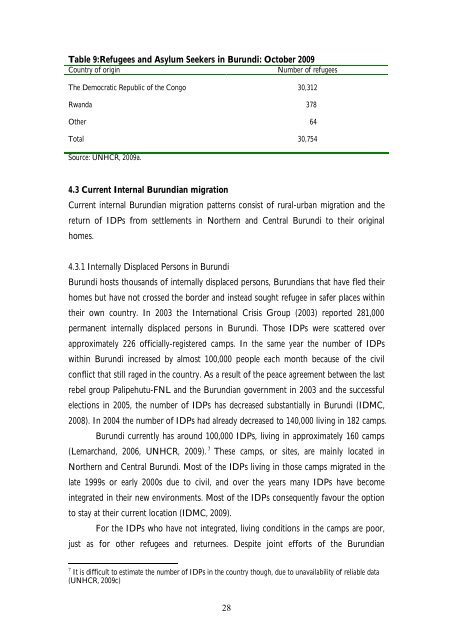Migration in Burundi: History, Current Trends and Future - MGSoG ...
Migration in Burundi: History, Current Trends and Future - MGSoG ...
Migration in Burundi: History, Current Trends and Future - MGSoG ...
Create successful ePaper yourself
Turn your PDF publications into a flip-book with our unique Google optimized e-Paper software.
Table 9:Refugees <strong>and</strong> Asylum Seekers <strong>in</strong> <strong>Burundi</strong>: October 2009<br />
Country of orig<strong>in</strong> Number of refugees<br />
The Democratic Republic of the Congo 30,312<br />
Rw<strong>and</strong>a 378<br />
Other 64<br />
Total 30,754<br />
Source: UNHCR, 2009a.<br />
4.3 <strong>Current</strong> Internal <strong>Burundi</strong>an migration<br />
<strong>Current</strong> <strong>in</strong>ternal <strong>Burundi</strong>an migration patterns consist of rural-urban migration <strong>and</strong> the<br />
return of IDPs from settlements <strong>in</strong> Northern <strong>and</strong> Central <strong>Burundi</strong> to their orig<strong>in</strong>al<br />
homes.<br />
4.3.1 Internally Displaced Persons <strong>in</strong> <strong>Burundi</strong><br />
<strong>Burundi</strong> hosts thous<strong>and</strong>s of <strong>in</strong>ternally displaced persons, <strong>Burundi</strong>ans that have fled their<br />
homes but have not crossed the border <strong>and</strong> <strong>in</strong>stead sought refugee <strong>in</strong> safer places with<strong>in</strong><br />
their own country. In 2003 the International Crisis Group (2003) reported 281,000<br />
permanent <strong>in</strong>ternally displaced persons <strong>in</strong> <strong>Burundi</strong>. Those IDPs were scattered over<br />
approximately 226 officially-registered camps. In the same year the number of IDPs<br />
with<strong>in</strong> <strong>Burundi</strong> <strong>in</strong>creased by almost 100,000 people each month because of the civil<br />
conflict that still raged <strong>in</strong> the country. As a result of the peace agreement between the last<br />
rebel group Palipehutu-FNL <strong>and</strong> the <strong>Burundi</strong>an government <strong>in</strong> 2003 <strong>and</strong> the successful<br />
elections <strong>in</strong> 2005, the number of IDPs has decreased substantially <strong>in</strong> <strong>Burundi</strong> (IDMC,<br />
2008). In 2004 the number of IDPs had already decreased to 140,000 liv<strong>in</strong>g <strong>in</strong> 182 camps.<br />
<strong>Burundi</strong> currently has around 100,000 IDPs, liv<strong>in</strong>g <strong>in</strong> approximately 160 camps<br />
(Lemarch<strong>and</strong>, 2006, UNHCR, 2009). 7 These camps, or sites, are ma<strong>in</strong>ly located <strong>in</strong><br />
Northern <strong>and</strong> Central <strong>Burundi</strong>. Most of the IDPs liv<strong>in</strong>g <strong>in</strong> those camps migrated <strong>in</strong> the<br />
late 1999s or early 2000s due to civil, <strong>and</strong> over the years many IDPs have become<br />
<strong>in</strong>tegrated <strong>in</strong> their new environments. Most of the IDPs consequently favour the option<br />
to stay at their current location (IDMC, 2009).<br />
For the IDPs who have not <strong>in</strong>tegrated, liv<strong>in</strong>g conditions <strong>in</strong> the camps are poor,<br />
just as for other refugees <strong>and</strong> returnees. Despite jo<strong>in</strong>t efforts of the <strong>Burundi</strong>an<br />
7 It is difficult to estimate the number of IDPs <strong>in</strong> the country though, due to unavailability of reliable data<br />
(UNHCR, 2009c)<br />
28



